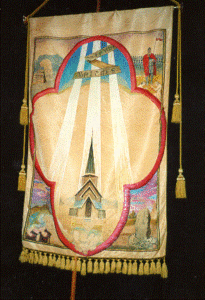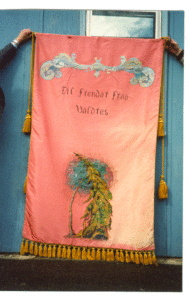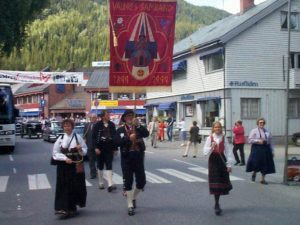The Original Valdres Fane – used from 1923-1999
 The Valdres Fane (our Samband banner) is on display in a prominent place at every stevne. It was presented to the Samband in 1923. But how many know what that tall banner is and where it came from?
The Valdres Fane (our Samband banner) is on display in a prominent place at every stevne. It was presented to the Samband in 1923. But how many know what that tall banner is and where it came from?
A group of Valdres-Americans visited Valdres in 1923 to observe the 900th anniversary of the Christianization of the Valdres by St. Olav. At one of the programs on Olavsdagen, 1923, Olav Moe, president of the Valdres Ungdomslag (young folks association) presented the fane to the Valdres Samband. Dr. O. E. Brandt received the fane on behalf of the Samband and interpreted the banner’s symbols. A. M. Sundheim spoke expressing his appreciation and concluded his remarks: “The beautiful Valdres fane which our home communities’ youth have presented the Valdres Samband shall in the future wave over our stevne as a symbol of the family feeling which Norway with its King and people create among all who emigrate from here as we experience how warmly the hearts here at home beat for us.”
The Valdres Ungdomslag commissioned Tidemand Gjorud to paint the design for the fane. It is printed on blue silk. Hedal’s stave church is in the center, with light streaming down upon it from heaven. To the upper left is the famous Vangstenen runestone; the upper right is King Olav. In the lower right is the other famous Valdres runestone, Einangstenen. To the lower left is a Valdres home in flames. The Valdres did not let themselves become Christianized willingly and were brought to their knees only after King Olav and his followers made a show of force, including the burning of some homesteads.
 On the reverse side of the fane is the inscription “Til frendar fraa Valdres” – “To our kinsmen from Valdres” Below this are two trees, one a deciduous tree and the other a pine tree, their limbs entwined, probably symbolizing the close relationship between Valdreses in America and Norway.
On the reverse side of the fane is the inscription “Til frendar fraa Valdres” – “To our kinsmen from Valdres” Below this are two trees, one a deciduous tree and the other a pine tree, their limbs entwined, probably symbolizing the close relationship between Valdreses in America and Norway.
The fane has graced every Valdres Samband stevne since it was presented. When you attend the stevne, go up and examine the front and back of it. As you look at it, remember the explanations of the symbols. Then as you sit back in your chair at future stevner and see the fane, you will know what it is and from where it came.
Excerpts take from Budstikken, May 1989 issue.
The New Valdres Fane – presented by the Valdres Historielag in 1999
 After 76 years of display and one return trip to Valdres in 1976, the old fane, a little worn and frayed, was displayed for the last time at the stevne in Willmar in June 1999, the centennial anniversary of the Samband as the oldest by gdelag in America. The old fane now has been retired and resides at Vesterheim Museum in Decorah, Iowa.
After 76 years of display and one return trip to Valdres in 1976, the old fane, a little worn and frayed, was displayed for the last time at the stevne in Willmar in June 1999, the centennial anniversary of the Samband as the oldest by gdelag in America. The old fane now has been retired and resides at Vesterheim Museum in Decorah, Iowa.
Those of you who attended the June stevne in St. Cloud this year may have noticed a new member making its American debut. This member is the Samband’s new fane. As a part of the centennial celebrations last summer, the Valdres Historielag presented a new silk fane to the Samband on June 30, 1999, at the opening of the stevne in Fagemes.
The Valdres Historielag’s group leader, Ola Hjelle, made the presentation of the new fane to the Samband’s president, June Adele Dolva. Ola pointed out that the new fane was not intended to replace the old one, merely to serve as an addition!
The fane was designed by artist Sigmund Arseth and painted on red silk by his brother, Kjell. A stave church motif is represented. June Adele promised to honor it and take care of it.
The new fane is bright and new and just as beautiful as the one given to the Samband in 1923. It will reign over many future stevner with all its glory, just as the one received in 1923 did.
To our ancestors and to the Valdres Historielag, we want to say “Thank you very much.”
Excerpts taken from Budstikken, December 2000 issue.